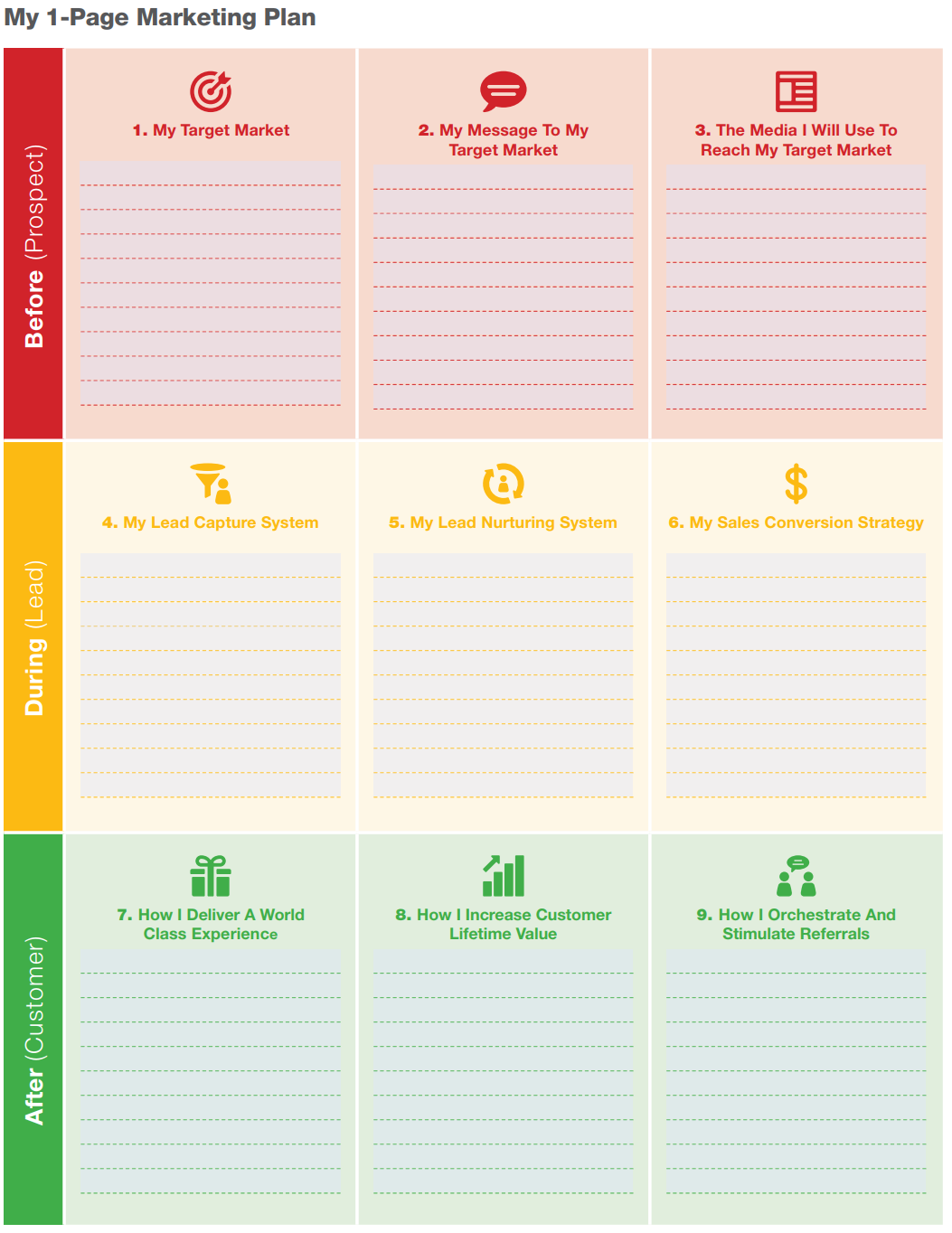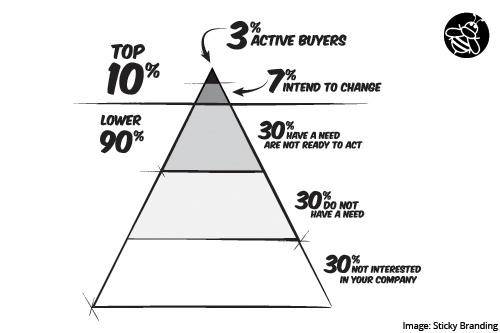Menu

In the last article (7 Steps To Systematically Test Marketing Channels) we covered the Bullseye Framework (7 steps) for testing different traction channels. Now that you’ve tested some channels and (hopefully!) gotten a sense of which one(s) work, you’re ready to create your 1-page marketing plan (3 more steps).
It’s going to be amazing! Buckle your seatbelts.
Aha! Note: In the last article, I talked about focus (on one traction channel) being valuable for early stage startups. Once your company reaches a certain size and has more resources, it’s possible to leverage multiple media/channels to reach your target audience. Even though one traction channel will always dominate, if you have the budget/resources, you should be able to diversify across multiple channels.
I’m a visual person (maybe you, too?) so I’m going to share the visual of the plan first before I jump into the sections.
Take a look below ... let it soak in.

(BONUS! I included a link to TWO filled out plans at the end of the post, one is B2C and the other is B2B focused.)
This is the template created by Allan Dib in his book, The 1-Page Marketing Plan. The quotes featured here are directly from the book.
I have not found a more succinct, helpful resource out there. You don’t need a 25-page plan to create your road map and drive strong results. You simply need to understand the key sections and how they fit together.
Allan Dib writes,
“The marketing process is a journey we want to guide our ideal target market through. We want to guide them from not knowing we exist right through to being a raving fan customer.”
It’s not a straight journey, and that’s okay. As long as you have the key ingredients and understanding, you can create a winning marketing plan.
During the Before phase, the goal is to get prospects to know you and have them show interest in what you’re offering. There are four sections in the Before phase (and for every phase).
Someone recently asked me if, with their new patented product, should they target a specific group of women experiencing a specific problem OR should they go after the mass market? I told them to read this article (kidding!).
Your target market should never be everyone (this means NO ONE). Mass marketing, especially when you’re an early stage company, is NEVER a good idea. You might think, “Look at Netflix. Everyone uses them,” or “Wal-Mart ... everyone goes there.” It’s a mind trick you’re playing on yourself. Even these companies started out with a niche (target) audience and, once they were successful with that segment, they were able to expand out and capture more segments.
I would argue that for a company to continue to be successful, they still need a focused, targeted message and approach (or risk watering it down so that it’s ineffective).
From Allan Dib,
“The type of niches that you want to go after are an inch wide and a mile deep,” meaning you’re highly targeting in a category, AND there are a lot of people looking to solve a specific problem.
Then it’s time to do some intentional consumer research and create an “avatar” or “persona.” More on voice of the customer research and creating buyer personas in a separate post (there’s just too much juicy goodness to include it all here).
Once you understand your target buyer’s perspectives, it’s time to work on your messaging. You CAN’T be boring, no matter what industry you’re in. Otherwise, you’ll blend in and be ignored (or purchased based on lowest price).
Some notable points from the book:
Starbucks’ value prop is being your “third place” (after home and work) or “affordable, luxurious experience.” Dunkin’s value prop is “innovative, fresh coffee/food fast.” Know your value prop.
I couldn’t agree more.
This is where you’ll need a marketing budget to propel your message out to your target audience. This is also where you’ll need to track how much you’re spending to make sure you’re getting a positive ROI.
Guess what. We already covered testing traction channels in the last article, so here’s where you’ll plug in the successful channels.
Great point from the book:
“... have an unlimited budget for marketing that works.”
I love this, not because I’m a marketer and an unlimited budget sounds amazing, but because it makes logical SENSE. It’s one thing if you’re testing (fail cheap!) but another thing if you’ve found what works.
Aha! Note: this section is actually something I added to each Phase, because every marketing strategy/plan needs to have end goals that you’re working towards. Otherwise, how do you know if you’re successful? A Before Phase objective could be: "Increase website visitors by 10% each month."
The goal of the During phase is to get leads to like you and buy from you for the first time.
Your lead capture system is essentially your CRM (Hubspot, Salesforce, Zoho, Google Sheets...that last one is not sustainable, though!).
At any given time, only 3%* of your target market is ready to buy.
The rest, not so much. That’s why it’s important to put them in your database and build the infrastructure to capture, nurture, and eventually convert them.

Aha! Note: *The 3% Rule is covered in Jeremy Miller’s book Sticky Branding. The original research started with his work in the recruiting industry mapping engagement rates of job seekers. He then extended it to buying trends and has found it a valid model for 15+ years.
You don’t have to send a personalized card in the mail every month in order to nurture your leads. I mean, you can if you want. Other ways to nurture your relationship (some of these also work really well with your significant other):
Aha! Note: some of these nurturing tactics can be pricey. Make sure your CAC is lower than your CLV.
How do you organize your nurturing activities? As I always say to my husband, “If it’s not on the calendar, it’s not happening,” (he then frowns). Your marketing calendar can include sending a weekly email with a link to your new blog post, sending a quarterly postcard, and sending a yearly gift basket. These are scheduled activities.
You will want to think about event-triggered marketing activities, too. For example, someone subscribed to updates from your website, so add them to your CRM system and (automate) an educational video series over the next month. Someone called in to ask about your services, so add them to your CRM (unless they’re already in there, then just add some notes) and send them a handwritten card and small gift.
Congrats! Converting someone to a buying customer is HUGE. I only have a few key points:
A During phase objective could be “$5MM in new business this year.”
The final phase!! The goal of the After phase is to get customers to trust you, buy from you regularly and bring you referrals (new business).
How? Read on.
What happens after the sale is just as important (perhaps even more important!) than the steps taken before the sale. Why? Because business growth comes from those customers who are your raving fans.
Aha! Note: What’s your company’s renewal rate? Strive for 90% (of your customers) or more. It’s harder to get a new customer to buy (see HBR, 5X-25X harder) than it is to get repeat business.
If you want customers to buy from you regularly:
This is all about getting existing customers to buy more from you. There are several ways to accomplish this including:
Another way to increase CLV is … increase your prices!
There are really two main ways to do this:
An After Phase objective could be “$20MM in repeat business this year.”
So, now that we’ve gone through all the details, I’m going to give you a couple of filled out 1-Page Marketing Plans that I personally put together. There’s a slide for B2C and one for B2B. Here's another way to look at it which I prefer, and you can make a copy and use for your own purposes (Google Sheets).
Are you a VC funded startup that needs help with your marketing? Book a free 30 minute consultation. I’ll ask you some questions about your product, the problem it solves, your buyer, your marketing efforts, and business goals. We’ll get to know each other. I’ll try to help you right away.
Top 5% podcast exploring the role that customers play in helping companies build to their next level of growth. 250+ episodes, 4.8 stars.
One Insight is a newsletter that highlights one unique insight I’ve uncovered, been thinking about, or seen in the wild. It usually makes me go "woah."